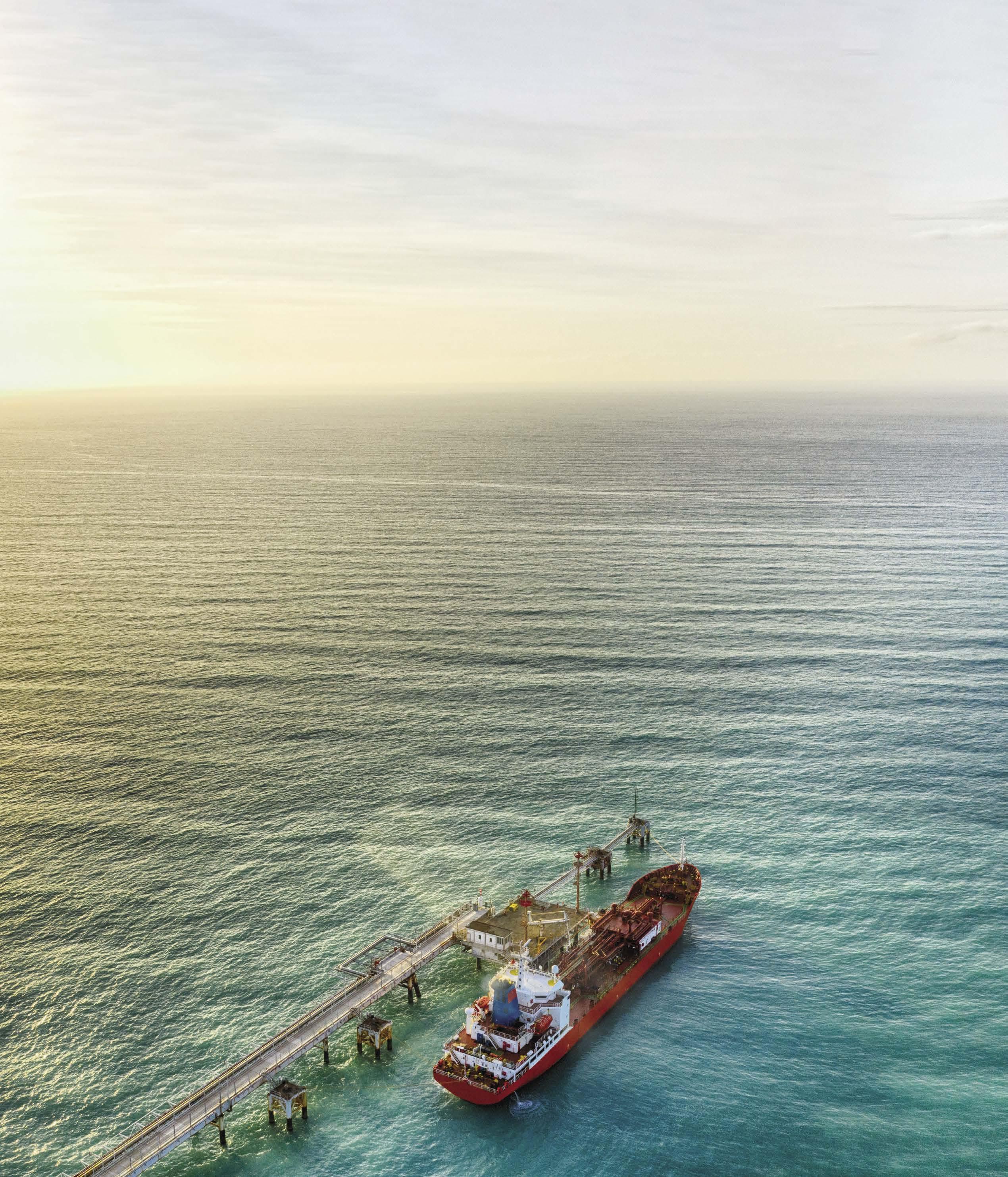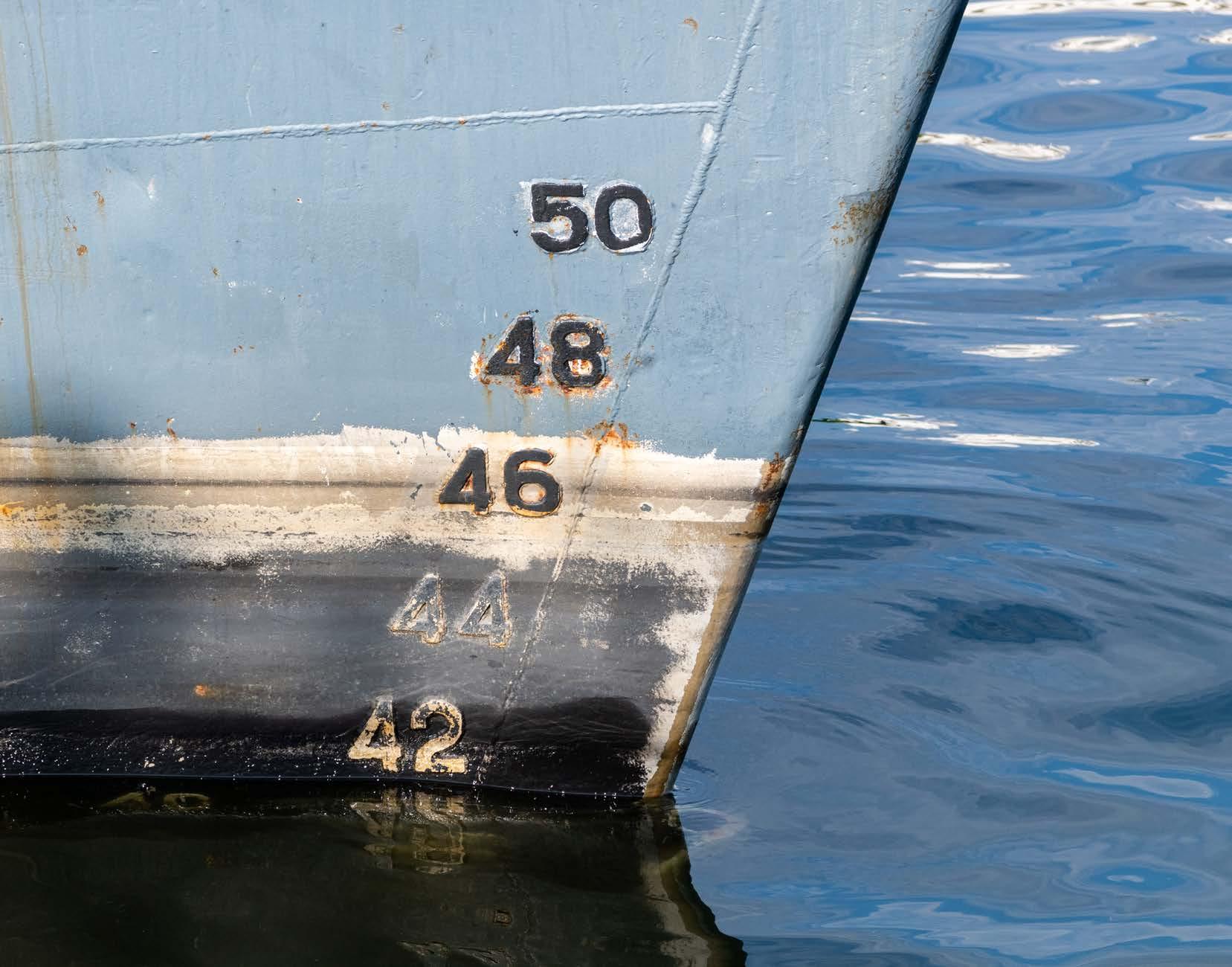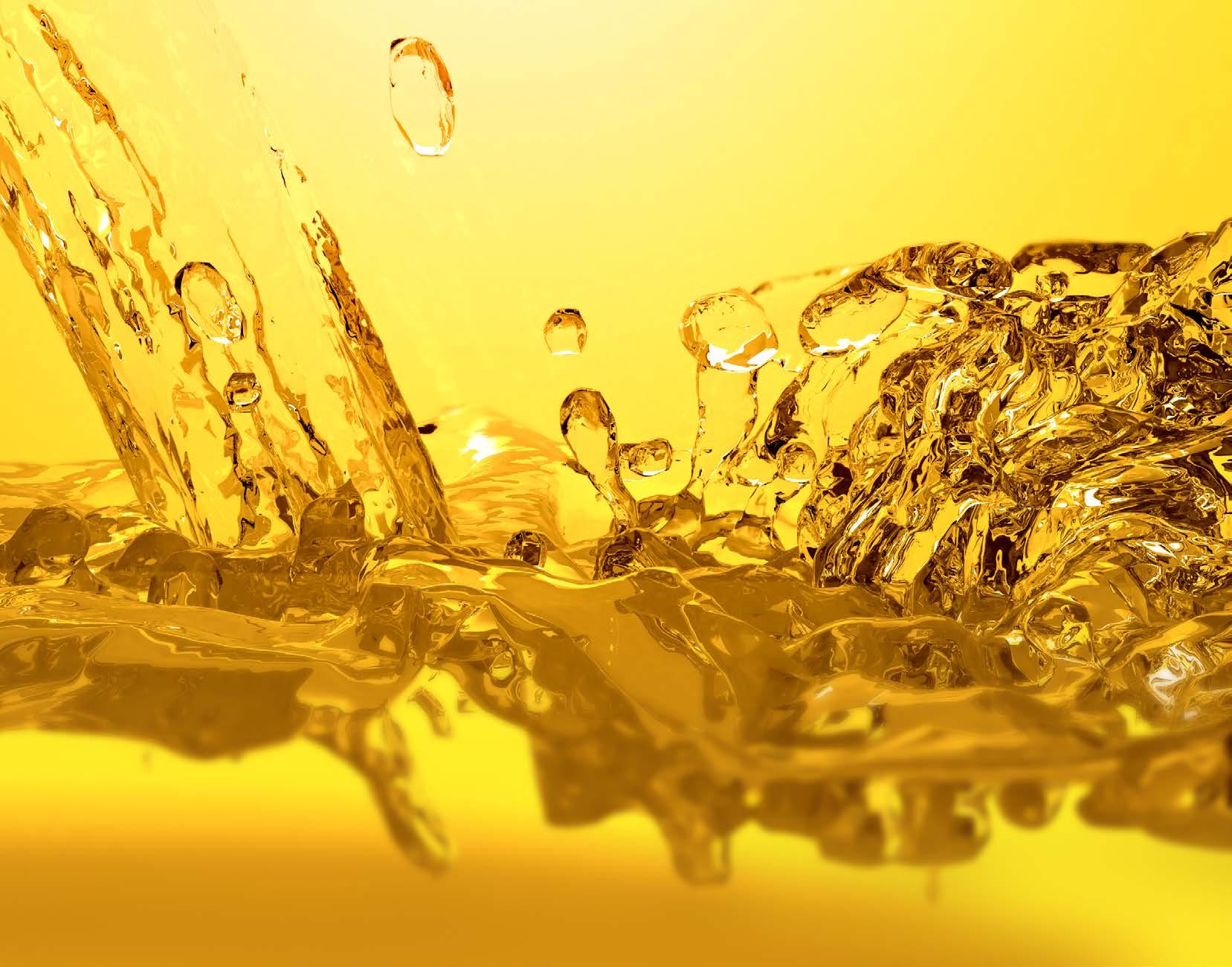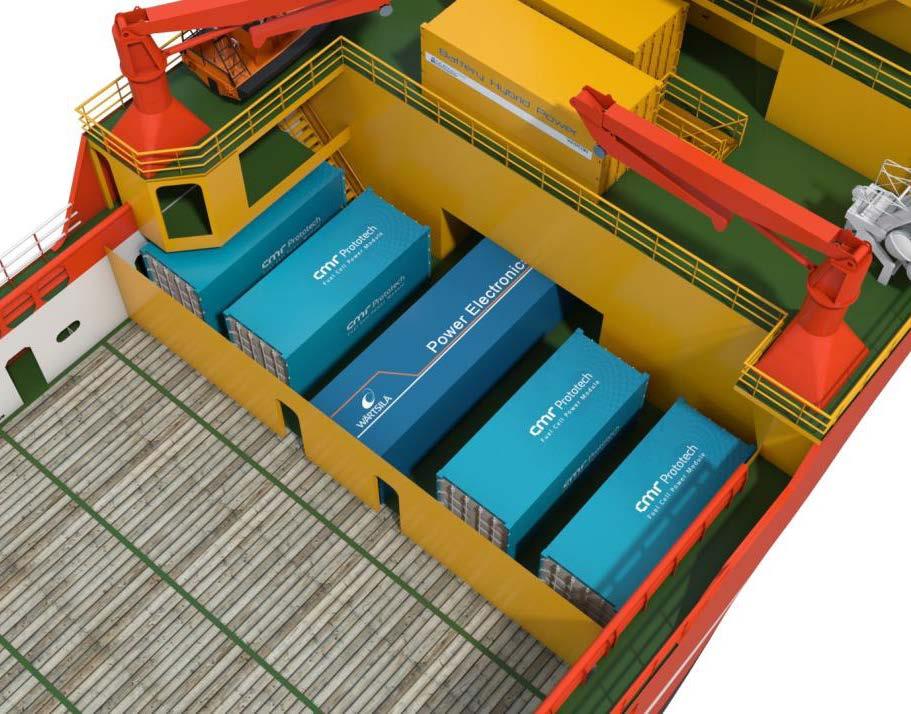
15 minute read
WIND POWER
from CSI Spring 2021
by Maritime-AMC
There has been a certain amount of scepticism in some quarters following the failure of a few initiatives down the years, but auxiliary wind power is beginning to attract attention once again
Sail streaming tests on a VLCC (Photo ©Korea Shipbuilding and Offshore Engineering)
SAILING INTO THE WIND
The world stood up and took notice when Maersk Tankers elected to trial Norsepower rotor sails on the LR2 tanker Maersk Pelican.
Following a year of operations, Norsepower’s CEO Tuomas Riski claimed that the calculated fuel savings were 8.2%. Although this particular installation was a retrofit, he said there was a huge opportunity for fitting auxiliary wind power on newbuildings, as this would prove the cheaper option.
The Maersk Pelican was recently sold and it is not yet known whether the new owner will retain the rotor sails on board. However, Riski claimed that an installation and operation of rotor sails could save anywhere between 5% and 20% of fuel and thus emissions without changing the profile of the ship.
The installation costs will also come down, if shipyards built the concept into their designs at an early stage. Riski called for shipbuilders to include the possibility of fitting sails at an early phase of the design stage of a newbuiding. In today’s worldwide weather pattern, Riski claimed that an owner or operator could see a return on investment (ROI) after four years or less and the concept would work on most type of ships.
There were several practical elements that needed to be considered before locating the sails, such as structural criteria, including deck strength and vessel stability, sight of navigation from the bridge, control system automation integration and others. A risk assessment should be carried out again at an early stage of the design stage which could alleviate problems at a later stage.
Most of the initiatives on offer and others that are in the pipeline designed to achieve the severe reduction in carbon emissions called for in 10-20 years time will be market driven. For example, in the secondhand sale and purchase market, a ship’s energy consumption and emissions will be taken into account going forward.
It was thought by some stakeholders that the potential for savings when using sails was higher in smaller and slower vessels. A
vessel’s geographic trading area and service speed will need to be taken into account while doing the calculations.
In the future, compliance with regulations in force and those pending, will be key and stakeholders will need to see what’s coming over the horizon. The rationale for fuel savings is ever more important as the shipping industry moves forward with new fuels.
Shipyards will also need to think outside the box with the new regulations and fuels being talked of. They will have to be more flexible and not try to charge a premium for new technology with their designs.
Financiers are now taking on board the need for more efficiently designed ships, as both the Energy Efficiency Design Index (EEDI) and Energy Efficiency Existing Ship Index (EEXI) reporting systems will mean that a ships must reduce their emissions and fuel consumption. EEXI is due to come online in 2023.
The Poseidon Principal grouping of leading banks willing to invest in new tonnage must see that they are operationally efficient to enable the assets to keep their value for the secondhand market.
Somewhat surprisingly, all of the stakeholders – shipyards, shipowners, financiers, designers and so on – were showing interest in this concept with enquiry reported as high. New initiatives, such as sails fitted on board, will be tackled by co-operation and joint ventures.
Norsepower has also installed two 35m tall rotor sails on a Sea-Cargooperated vessel. This installation was claimed to be the world’s first tiltable rotor sail, proving that vessels that need to sail on height-restricted routes can benefit from this fuel and emissions-saving solution.
CONSIDERABLE SAVINGS
According to the analysis conducted by Norsepower and Sea-Cargo, the installation — fitted on board the SC Connector, a 12,251 gross tonne (GT) side-door ro-ro — can achieve a fuel consumption, fuel cost and carbon emissions reduction of up to 25%. In good wind conditions, the vessel will be able to maintain her regular service speed by sail alone.
Norsepower’s rotor wail solution is an updated version of the Flettner rotor, a spinning cylinder that uses an aerodynamic phenomenon known as the Magnus Effect to harness wind power to produce thrust for a ship.
SC Connector, which sails between Western Norway, Denmark, the Netherlands, Sweden and Poland, sails under multiple bridges and powerlines, requiring adaptation of the rotor sails to tilt to the almost horizontal when the vessel is required to operate at a low air draft.
Riski says of the Sea-Cargo installation: “Completing the installation has been extremely rewarding, as it reflects how, in taking a collaborative approach with a customer, we can innovate to create solutions that allow rotor sails to benefit almost any vessel type or trading route.
“As we get closer to 2030 IMO targets, we are seeing our technology gaining momentum — with the market seeing the flexibility we can provide to suit different vessel requirements. This installation demonstrates the technology can go a long way to futureproofing IMO GHG compliance, while ensuring significant emissions, and fuel reductions to a variety of vessel profiles today.”
Ole Sævild, Sea-Cargo managing director, adds: “We are focusing on utilising available renewable energy and using it for direct propulsion to design more environmentally friendly vessels. The rotor sail technology has been proven in the market for a while, but the size is unique for our project. The sails are far more efficient than conventional sails of the same size and the tilting function is essential to our voyage routes. Given the estimated emissions savings, we will use our experience of this full scale project, and proceed to develop it further for other vessels in our fleet.”
Norsepower’s rotor sail is fully automated and detects whenever the wind is strong enough to deliver fuel and emission savings, at which point the sails will start automatically.
Following the Sea-Cargo fitting, Norsepower announced it had won its first newbuilding order, for the installation of five tilting rotor sails on board a large bulk carrier. Preparations are currently taking place with the installation on board scheduled for this year.
At present, the owner wishes to remain anonymous thus little detail has been released thus far.
TESTING TECHNOLOGIES
Elsewhere, a new research project focused on combining emerging technologies to promote low-carbon shipping will test its technologies on in-service vessels.
The project, which is named CHEK (deCarbonizing sHipping by Enabling Key technology symbiosis on real vessel concept designs), is receiving funding from the EU Horizon 2020 programme to accelerate innovation with tests of a sail on a drybulk carrier, as well as a hydrogen-powered ship engine on a cruise ship.
“No current or emerging ‘silver bullet’ technology alone will be able to reduce CO2 emissions from maritime transport in accordance with the IMO’s ambitious 2050 goals,” explains CHEK project co-ordinator, Dr Suvi Karirinne, who heads VEBIC, Finland’s University of Vaasa’s energy and sustainability research platform. “The shipping of the future must combine emerging technologies into a systemically symbiotic entity.”
The CHEK project aims to reduce shipping emissions by bringing lowcarbon energy forms and various technologies such as hydrogen, wind power, electric batteries, heat recovery, air lubrication and new anti-fouling technology to vessels, as well as developing the way vessels are designed and operated.
A symbiosis of new innovative technologies will be created that can reduce 99% of GHG emissions, achieve energy savings of up to 50% and reduce black carbon emissions by more than 95%.
Research efforts will be applied to current vessels. For example, a Cargill bulk carrier will be fitted with the wing sail technology under development by the UK’s Bar Technologies.
BAR and Cargill will develop a solid wing sail system, based on racing yacht design, for a Kamsarmax type bulker, which will also feature automated,
optimised vessel routing, waste heat recovery, hull form optimisation and a gate rudder.
By designing the overall layout to optimise the benefits from the combination of technologies used, the efficiency savings will be maximised, the companies claimed.
“Wind propulsion will be a cornerstone of low-carbon shipping in the future, with the versatility to deliver efficiency savings regardless of the power train used,” says John Cooper, BAR Technologies CEO. “However, it is most effective as part of a wider suite of de-carbonisation technology, and especially when designed into the vessel platform from the beginning.”
Set to begin in June, 2021,CHEK will run for 36 months and will involve the University of Vaasa, World Maritime University, Wärtsilä, Cargill, MSC Cruises, Lloyd’s Register, Silverstream Technologies, Hasytec, Deltamarin, Climeon, and BAR Technologies.
BAR is a spin-off from Ben Ainslie Racing (BAR), the British team formed by Olympic and World Champion sailor Sir Ben Ainslie. It was formed in 2016 to bring the design knowledge, technical skills and intellectual property developed for America’s Cup yacht racing to the commercial world. The company is led by chairman Martin Whitmarsh – former McLaren team principal – CEO, John Cooper – former McLaren chief business officer – and former America’s Cup designer and engineer, Simon Schofield.
ECO-TECH TIE-UP
Meanwhile, Kim Diederichsen, CEO, Anemoi Marine Technologies, tells Clean Shipping International that the key to achieving both EEDI and EEXI and, ultimately IMO’s overarching carbon reduction targets, is to integrate and optimise a range of eco-technologies that complement each other.
This the reason that wind-power specialist Anemoi Marine Technologies has teamed up with maritime propulsion giant Wärtsilä in October last year.
Anemoi is a producer of on-board Flettner Rotors, known as rotor sails. These are tall, cylindrical sails fitted to the upper deck of vessel. A small motor is used to rotate the sails and this harnesses the renewable power of the wind to propel the ship through the water. In essence, these are mechanical sails, but instead of using the wind in a conventional way, rotor sails capitalise on the Magnus Effect to deliver additional thrust to the vessel.
Anemoi’s solution has been operating successfully on board ship for three years and is proven to deliver significant efficiency savings, Diederichsen claimed. Unlike other similar installations, Anemoi’s rotors are designed to either fold from vertical to horizontal, or move position on a set of rails thus not interfering with the daily ship operations.
Depending on vessel type and trading pattern, Anemoi’s rotor solution has the potential to reduce fuel use and associated emissions by as much as 30%
To help newbuilding or existing vessels meet their EEDI/EEXI obligations, Wärtsilä offers a package of technologies that might include eco-efficient main engine and generators, rudder and propeller innovations, hull coatings, air lubrication systems, fuel mix, and alternative power sources, such as rotor sails.
Through its extensive experience, Wärtsilä is able to develop and optimise a combination of technologies that will best assist a particular vessel significantly enhance its efficiency rating.
From Anemoi’s perspective, the tie-up with Wärtsilä is much more than simply integrating the physical technologies within the hull. By working together, added efficiency can be drawn from the technology.
It’s generally considered that the larger vessel classes — such as VLOCs and VLCCs — find it more challenging to meet their EEDI targets. Anemoi believes that a 325,000dwt VLOC fitted with its rotors could achieve an 18% fuel and emission reduction. On a standard China to Brazil route, the savings can amount to 5,357 tonnes of carbon each year.
Similar calculations for a VLCC sailing from the US Gulf to China show a 17.3% fuel reduction, which equates to 7,044 tonnes of carbon saved each year, Diederichsen says. Larger ships will generally take ocean routes where the wind tends to be stronger and more predictable, which makes them ideally suited to the rotor sail solution.
Diederichsen says that Anemoi is confident that its rotors are suitable for most vessel classes and has recently completed a feasibility study proving significant savings for a ro-ro trading in northern European.
Germany’s Oldendorff Carriers has also signed a joint development project (JDP) agreement with Anemoi, Lloyd’s Register (LR) and Shanghai Merchant Ship Design and Research Institute (SDARI). The JDP aims to break down significant barriers to the installation of rotor sail technology and pave the way for commercial-ready applications in the short-term.
Oldendorff says that by fitting vertical rotors on a Newcastlemax-type bulker of 207,000dwt, wind propulsion can be tested on long-haul voyages and it will decide whether to proceed with the installation on board one of its vessels once the results of design and study phases of the JDP have been evaluated.
To ensure the Anemoi-patented vertical rotors do not interfere with cargo operations and air draft limitations, the sails are mounted with a folding system that enables them to be lowered from vertical into a horizontal position on deck.
“This JDP, together with other ongoing projects in our company, is a testament to our commitment to the development and application of green technologies across our fleet,” says Torsten Barenthin, director innovation at Oldendorff Carriers.
“By partnering with the ship designer (SDARI), manufacturer (Anemoi) and classification society (LR), we seek to achieve a comprehensive functional application of wind technology that returns environmental and commercial benefits throughout our vessels’ entire life cycle,” he says.
There are several other initiatives to fit sails on vessels in the pipeline. Clean Shipping International will report on these in future editions, once they have been fitted on board ship.
IMO BANGS THE DRUM
During the middle of February, an International Maritime Organization (IMO)-run symposium looked at the various low- and zero-carbon marine fuels that will allow shipping to meet its emissions targets.
However, it was agreed that more work was needed to address availability, safety and other issues.
Fuel options’ state-of-play were discussed and the technical aspects of various low-carbon and zero-carbon fuels were explored. Other issues, such as safety, regulation, pricing, infrastructural availability, lifecycle emissions, supply chain constraints, barriers to adoption and more were also aired.
Detailed research and solutions were presented on a wide range of alternative fuels. Strong candidates, which are already being trialled on ships, include hydrogen, ammonia and methanol. Wind-propulsion was also highlighted.
Information was also shared about practical lessons learned from the use of the currently available alternative fuels, such as liquefied natural gas (LNG) and biofuels, which also highlighted the potential of further reducing the greenhouse gas (GHG) emissions associated with their use, for instance, reducing methane slip or increasing the use of bio-gas.
“To reach a low- and zero-carbon future for shipping, we will need new technologies, new fuels and innovation,” IMO Secretary General Kitack Lim said in his opening remarks. “Exciting research and development into low- and zerocarbon marine fuels is already underway. IMO wants to further accelerate such initiatives by providing the global forum for sharing knowledge, to promote R&D and to build partnerships between stakeholders and among public and private sectors, not only in the shipping industry and ports, but also private and development banks, and academia at international, national and local levels.”
As for safety, the symposium highlighted the need to discuss and address concerns around the use, bunkering and storage of emerging fuels, given the different characteristics of each individual fuel.
Many participants highlighted the need for an intensified effort to further develop the International Code of Safety for Ships using Gases or other Low-flashpoint Fuels (IGF Code), in order to keep pace with new fuels making their way on to the market.
IMO’s Sub-Committee on Carriage of Cargoes and Containers (CCC) is responsible for the IGF Code. Member states were asked to share information with the CCC Sub-Committee to ensure that technical discussions are robust.
Crew training on safe handling of alternative fuels was also emphasised, as individual fuels have different requirements for temperature, viscosity, on board storage and engine operations.
Partnerships among stakeholders, together with clear policy and international regulations, were recognised as keyfactors in advancing towards shipping’s de-carbonisation.
The IMO stressed that it will play an active role as the global regulator of shipping and also as a promoter and coordinator of initiatives related to low/zero carbon alternative fuels. “We should not forget that the energy transition of shipping has both sides, a necessity and an opportunity,” said Sveinung Oftedal, symposium moderator.
“Shipping de-carbonisation is everyone’s business and co-operation across the maritime community and beyond would be essential to success. IMO stands ready to continue to be a global platform for knowledge sharing and promoting alternative fuels,” he added.
Most stakeholders Clean Shipping International has spoken to recently have agreed that the path towards zero emissions can only be achieved by a collaborative approach with safety and training at the top of the list when deciding on which route to take.
For example, Knut Ørbeck-Nilssen, CEO DNV GL – Maritime (to become just DNV on 1 March), said that the timeline towards zero emissions was underway and admitted that the IMO was under tremendous pressure. “Leadership is needed to meet the industry challenges,” he said. “Use the IMO as the best vehicle of safety and the environment.”
He saw this decade as one of innovation and collaboration and pleaded for a level playing field. However, he warned that de-carbonisation efforts would create a safety gap if left unmanaged, which could delay progress.
At the many presentations given by Ørbeck-Nilssen down the years, attended by Clean Shipping International’s editor in one guise or another, he has called the next 20-30 years “tectonic shifts” in the way shipping is run. In his midFebruary talk, he did not disappoint and made no apology for using this analogy again.
He has always been a staunch supporter of the IMO in being the body to take the industry forward against all the national and regional regulations that appear from time to time — not least from the European Union.












